Botanists classify bamboo as a subfamily of grasses, alongside corn, wheat, blue fescue, and ordinary sod. But when you see a towering grove of bamboo, growing more than 100 feet tall, it’s hard to think of it as a grass. Of course, not all bamboo varieties get that big. And some dwarf species only grow to about the size of a chopstick. But members of the genus Dendrocalamus are the kinds of bamboo that can overshadow most trees and make us feel like little pixies in an enchanted forest.
The genus Dendrocalamus includes 50-60 species of tropical, clumping bamboo, primarily native to Southeast Asia, India, and the Indonesian archipelago. These are some of the world’s biggest bamboos, including Dendrocalamus sinicus, the largest bamboo species of all, with culms well over 100 feet in height and more than 12 inches in diameter. They are known to shoot up more than three feet a day in the growing season. Certain Dendrocalamus species are especially important economically, and widely used for building and construction. Farmers around the world are currently examining their potential as a cash crop, based on their remarkable size, growth rate, and utility.
NOTE: This article first appeared in January 2021, last updated in October 2024.
Bamboo Genera
This is part of an ongoing series about different types and species of bamboo. To learn more about this fascinating and diverse subfamily of grasses, check out these useful articles.
- Introducing bamboo: Genus by genus
- Clumping bamboo
- Genus Bambusa: Paragon of bamboo
- Genus Fargesia: Clumping bamboo for cold climates
- Running bamboo
- Genus Chimonobambusa
- Genus Phyllostachys
- Herbaceous bamboo: Olyreae

Characteristics of Genus Dendrocalamus
Dendrocalamus are probably the largest bamboos in the world. Their sheer size and incredible rate of growth have amazed the people of Southeast Asia for millennia. With its practically supernatural properties, it’s no wonder we have so many myths and legends surrounding the origins of this gigantic bamboo. Most species of Dendrocalamus grow around 50 to 70 feet tall, and 4 to 6 inches in diameter, but some grow much larger.
Like most bamboo varieties in the tribe Bambuseae (a subdivision of the bamboo family), Dendrocalamus are tropical and clumping by nature. Truly tropical, they will not survive if the winter temperatures commonly fall below 30º F. Unlike the running bamboo varieties, these species do not spread aggressively and invasively. Yes, the individual culms can grow to astronomical proportions, but the plant itself tends to reach a maximum size with a limited footprint, usually about 10-15 feet across.
In addition to their massive size, many species of Dendrocalamus also have very thick culm walls. This makes them extremely hard and resistant to cracking. In other words, they provide a superior building material. And compared to how long it takes to grow a 100-foot-tall tree, the benefits over traditional lumber are obvious.
Culm internodes on Dendrocalamus are usually relatively short, just a few inches apart, especially closer to the base of the plant. The culms also produce ariel roots around the nodes at the bottom few feet. Higher nodes will produce multiple branches, usually with one larger, dominant branch. Often the branches are thorny.
Many members of the genus Gigantochloa are comparable in size to Dendrocalamus. But those varieties are usually recognizable by their pronounced aerial roots near the base of the culms and more persistent culm sheaths that cling to the younger poles.
Where to grow Dendrocalamus
Indigenous to tropical Asia, these kinds of bamboo require a warm climate to thrive. They have little or no tolerance for frost. For that reason, they are not commonly grown in North America. But bamboo lovers in warmer zones like Florida and Alabama may be lucky enough to grow these in their gardens. They can definitely grow in Hawaii as well, and southern California also has a few outstanding specimens.
Unlike Guadau, the most important genus of timber bamboo in the New World, Dendrocalamus is somewhat more versatile. Most species of Guadau, especially G. angustifolia, prefer the higher elevations of equatorial Colombia and Venezuela. They don’t grow as well in lower elevations or more temperate climates. But farmers are having great success cultivating Dendrocalamus species in various parts of Africa. Test crops are also underway in southern Europe, namely Portugal.

Species of Genus Dendrocalamus
There are approximately 60 species of bamboo in the genus Dendrocalamus. The following short list includes the most commonly cultivated, widely used and notoriously ginormous varieties. Numerous species use common names like Giant Bamboo and Dragon Bamboo, which can be confusing. So it’s better to refer to them by their botanical names for certainty and clarity.
Dendrocalamus asper
Not the largest species in this genus, but still big enough to be called Giant Bamboo. Dendrocalamus asper generally grows up to 50 or 60 feet tall and about 5 to 8 inches in diameter. The culms are thick and excellent for building, capable of supporting massive structures. The fresh shoots are also edible.
D. asper is native to Southeast Asia, typically growing in lower altitudes and requiring a substantial amount of rainfall. The species has also been introduced in Africa and Latin America for commercial cultivation and construction. It provides a far more affordable and renewable alternative to concrete and steel.
Another cultivar of this species is D. asper ‘Hitam’, a strikingly attractive variety of giant black bamboo. In Hawaii, this is a fabulous ornamental, growing 100 feet tall, but it won’t do so well in other parts of the US. In its native region of Java, it’s widely used for furniture and decorative building.
Check out the amazing architecture at the Green School in Bali to see what a master builder can do with this asper bamboo.
And see our in-depth article on Dendrocalamus asper to learn more about how it’s becoming the top choice for bamboo farmers around the world.
Dendrocalamus barbatus
Most similar to D. membranaceus, Dendrocalamus barbatus is another giant bamboo species with culm growing more than 50 feet tall and 3 to 4 inches in diameter. The poles are useful for construction and pulp production. Although rare, it also makes an attractive ornamental with graceful culms, free of branches on the lower portions. Native to Yunnan, and widely cultivated elsewhere in southern China, this species is somewhat hardier than other varieties of Dendrocalamus native to Southeast Asia and Indonesia.

Dendrocalamus brandisii
One of the largest bamboo species, this Southeast Asia variety grows as much as 100 feet tall with 5 to 8-inch thick culms. Sometimes called Velvet Bamboo or Teddy Bear Bamboo, young culms are dark gray with a soft texture, and turn to greenish-gray with age. In its native region, this giant bamboo is very widely used for building, construction and crafts.
The bulky young shoots of this variety are also prized for their delicious sweetness.
Dendrocalamus copelandii
This is an attractive species with abundant and generously sized leaves. In ideal conditions, culms can grow 60-70 feet tall and reach a diameter of 7-8 inches at the base. Young shoots have a thick, waxy coat underneath their culm sheaths.
Dendrocalamus copelandii is notably one of the ancestors of, Thyrsocalamus liang, an important intergeneric hybrid endemic to central Thailand.

Dendrocalamus dumosus
Strange as it sounds, this is a dwarf species of the giant genus. Growing only about 10 or 15 feet tall, this is an especially lovely ornamental for tropical climates. Slender, dark green culms have occasional black markings with some graceful arching at the tops. Native to Thailand and Malaysia.
Dendrocalamus elegans
Also from Thailand and Malaysia, this attractive species is pretty similar to D. dumosus, above. Thin culms, about 1 inch thick, have a silver-green color and grow about 15 feet tall. Leaves are feathery, but the foliage is dense, with a beautiful aspect. Also popular as a relatively compact ornamental in the right climate, where frost is very rare.
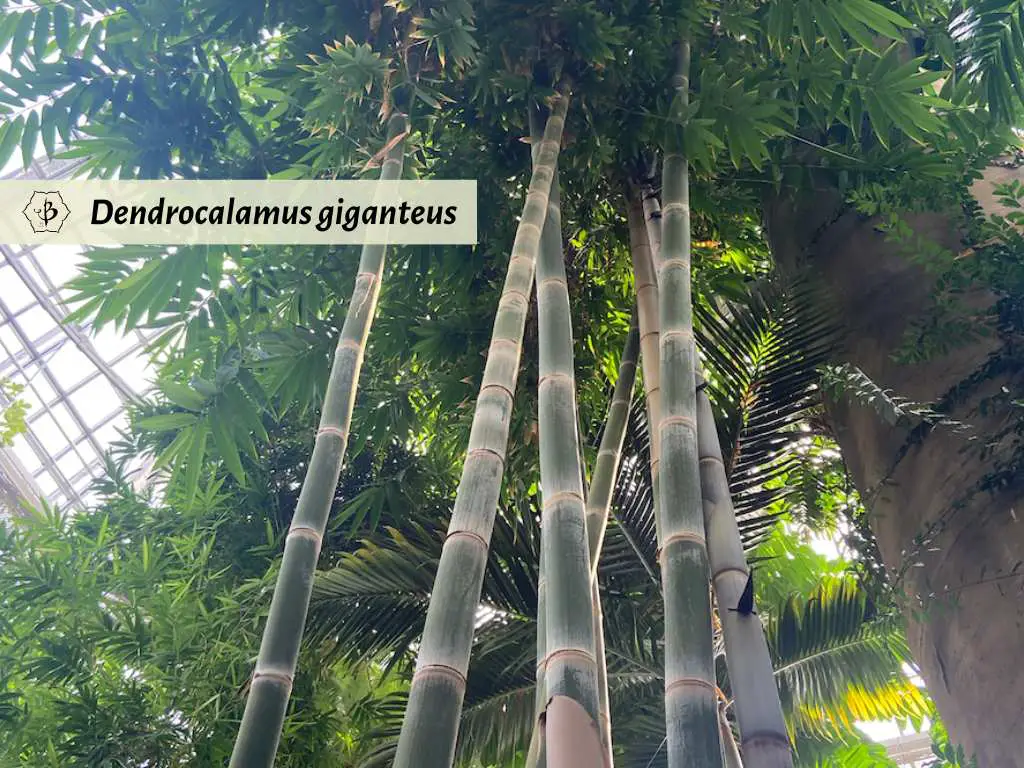
Dendrocalamus giganteus
Also called Dragon Bamboo, or simply Giant Bamboo, the name says it all. This remarkable species can grow more than 100 feet tall and up to a foot in girth; culms of 8 or 10 inches in diameter are not uncommon. New shoots appear with a dusty, grayish-green color, and gradually turn more brownish-yellow with age. Before the discovery of Dendrocalamus sinicus, botanists considered this to be the largest bamboo species in the world. In most respects, they are very similar to Asper, but with smooth culms, without the furry nodes.
Like most members of this genus, giganteus prefers a tropical habitat and will not tolerate temperatures below about 30º F. Gardeners in Hawaii and Florida can grow this species with dazzling results. You can also find a specimen at the San Diego Botanical Garden, but without the tropical humidity, it’s not quite as majestic.
Culms with their thick walls are ideal for construction and are used widely in Indonesia. The fresh shoots are also edible. Harvest them when they’re young and tender, and pickle them like sauerkraut. Or slice them into rings and add them to stir fry. Just remember to boil them first to remove any toxins.

Dendrocalamus hamiltonii
One of the medium-sized species, Dendrocalamus hamiltonii grows about 50 to 60 feet tall and 4 to 6 inches in diameter. As the clumps mature, the tall poles tend to arch over with something like an umbrella effect. Branching starts at the lower nodal joints, closer to the ground, unlike asper or giganteus. One way to recognize this species, which looks very similar to other Indian species of Bambusa, such as tulda and balcooa, is by the grayish color in the young culms.
Hamilton’s Bamboo, as it’s commonly known, grows more widely in the southern Asian areas of India, Nepal, Southern China, and as far east as Pakistan. These regions are less wet and tropical than Indonesia, and the species is relatively drought tolerant. If you’re looking for a timber bamboo to grow in Southern California or the desert, this could be a good option. Its natural distribution in the Himalayan foothills also makes this species more frost-resistant than other varieties of Dendrocalamus.
Not as big as giganteus or asper, Hamilton’s Bamboo is still a hefty specimen, with thick walls and abundant biomass. It is commonly used for paper making in southern Asia, and therefore may be at risk of becoming endangered. But it’s still fairly widespread in areas like Nagaland and Assam in Northeast India.
Dendrocalamus hookeri
Native to India, Myanmar, and Sri Lanka, this tropical species grows 50-60 feet tall. Culms grow 4 to 6 inches in diameter and have thick walls suitable for building and light construction.
Dendrocalamus latiflorus
Native to Southern China and Taiwan, this majestic timber bamboo is often called Taiwan Giant Bamboo or, like a handful of other edible species, Sweet Bamboo. Culms commonly grow 50 to 80 feet tall. Tender shoots are especially tasty, and mature culms are good for building. Vibrant green culms and a generous canopy of leaves make this a popular ornamental, but only in the right climates, including Southern California and South Florida. It’s a bit more adaptable than other members of the genus though, hardy down to about 25º.

Dendrocalamus maximuslamina
Another species of giant bamboo, D. maximuslamina is very similar to D. latiflorus, but as the name indicates, it has gigantic leaves. Like other members of the genus, the culms can grow 60-80 feet tall, perhaps more in ideal conditions. The leaves, however, are exceptional, more than a foot long and 3-4 inches wide. The fresh shoots are reported to be some of the most delicious of any bamboo variety.

Dendrocalamus membranaceus
This species closely resembles D. strictus, based on the size of the culms, the branching that starts at the base, and the adventitious roots on the first and second nodes. The leaves of membranaceus are thinner than strictus, however, and the culm leaves have hairier, wavy auricles. Young culms have a white, powdery coat.
This bamboo is widespread in Southeast Asia, preferring altitudes more than 1,000 meters above sea level. It is relatively drought-tolerant and is useful for construction, crafts, paper pulp, and edible shoots.
Dendrocalamus minor var. Amoenus
Ghost Bamboo, as it’s popularly known, is as alluring and elusive as its name. This exotic variety is something of a dwarf among the genus Dendrocalamus, only growing 20 or 30 feet tall. But the coloration of its culms, grayish-green with striking variegations, make it an especially desirable specimen among collectors. And with a name like Ghost Bamboo, who can resist? This ornamental species is quite popular in northern Australia.

The original species, D. minor, is also an impressive ornamental, but without the distinctive striping of the ‘Amoenus’ cultivar. Though smaller than its giant relatives, this species is extremely fast-growing and far more tolerant of non-tropical conditions. It grows especially well throughout Coastal California, if you can find any. (See photo collage at the top of the article, with D. minor on the left.)
The name Ghost Bamboo can apply to either the original D. minor or the striped cultivar, D. minor ‘Amoenus’.
Dendrocalamus pendulus
This a less common species of Dendrocalamus, found primarily on the Malaysian peninsula. Among the genus of giants, this is not the most massive species. Culms grow to about 3 or 4 inches in diameter, reaching heights of 60 to 80 feet, and arching gracefully. Lateral branching doesn’t tend to start until further up the culms, resulting in a more elegant appearance.
I only became aware of it because it is one of the parents of an exotic intergenetic bamboo hybrid, also specific to Malaysia. Gigantocalamus malpenensis is a naturally occurring cross between Gigantochloa scortechinii and Dendrocalamus pendulus.
(View my short clip on YouTube to learn more.)
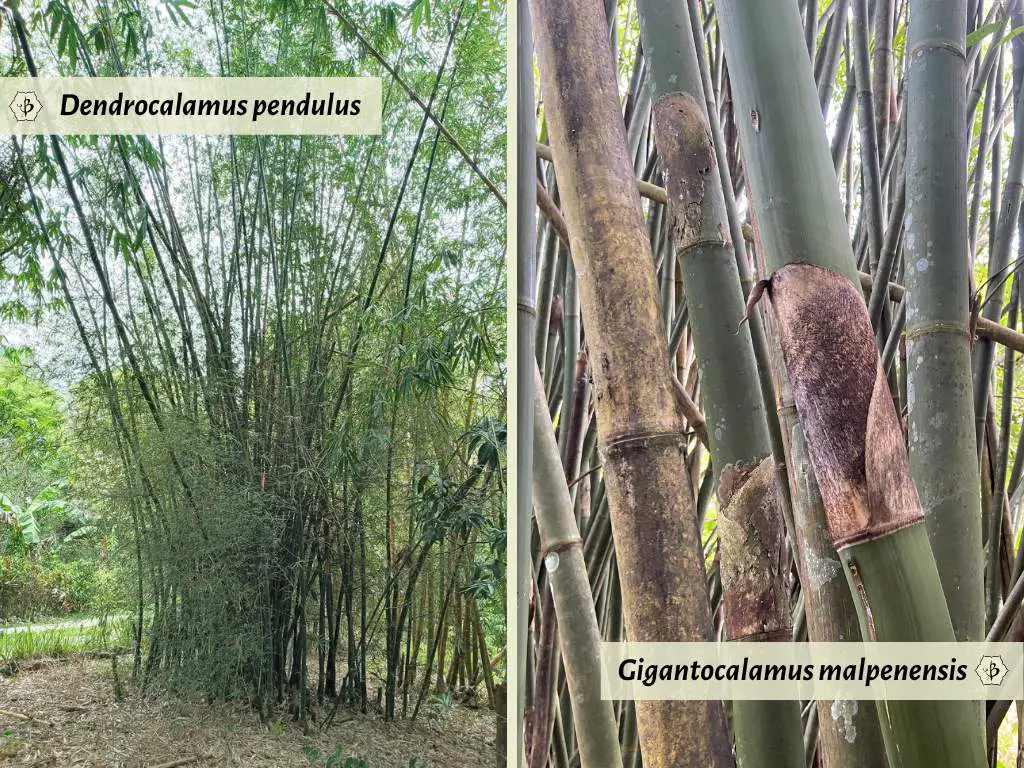
Dendrocalamus sinicus
Native to Laos and the Yunnan Province of southwest China, this exceptional species has the largest, tallest and thickest culms of any bamboo species. Its limited distribution makes this species less renowned than the famous D. giganteus, but it actually grows even larger. The largest known specimen was measured at 151 feet tall and 14.5 inches thick.
Sometimes called Giant Dragon Bamboo, Dendrocalamus sinicus has long enjoyed great prominence in Laos and southern China, but was only recently discovered by the outside world. This species has a very narrow distribution, typically growing at altitudes of 1,000 to 1,500 meters above sea level. It flowers sporadically rather than gregariously, with a very low rate of seed setting.
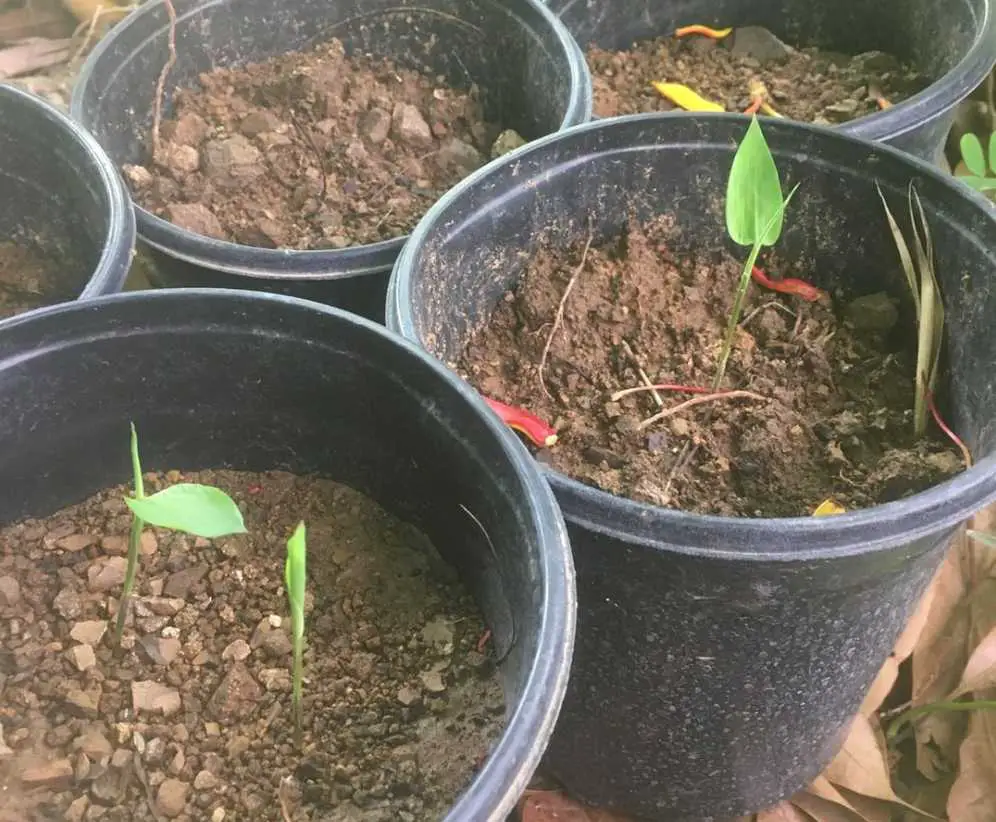
Dendrocalamus stocksii
This medium-sized species of Dendrocalamus is native to India and Southeast Asia. It is widely grown across the Indian subcontinent and considered one of the best commercial species because it has no thorns (unlike some comparable varieties of Bambusa) and its culms are nearly solid. It can be very useful for paper making and biomass production.
Dendrocalamus strictus
This is another modestly sized member of the genus, ordinarily growing 30-50 feet tall. But it holds a special place in our hearts, as Bambu Batu, the namesake of our company. In India, where it most commonly grows, they refer to the species as Male Bamboo, Solid Bamboo or Calcutta Bamboo. But in Indonesia, the Malay name for it is Bambu Batu, which basically means ‘stone bamboo”.
Like other varieties of Dendrocalamus, this one is extremely strong and hard, which is how it earned its name. In drier conditions, the culms grow solid, or nearly solid. It is somewhat drought tolerant, but this species prefers a humid, tropical climate. The plants have lots of lateral branches, and they flower frequently and sporadically. It is widely used for construction and paper making.
Watch the video above to learn more about this important species, or take a look at our detailed article on Dendrocalamus strictus.
Dendrocalamus validus
This exotic ornamental bamboo makes a spectacular specimen piece. Comparable in size to some of the larger Dendrocalamus species — 60 to 70 feet tall and 5-6 inches in diameter — the culms are smooth and deep green with little or no branching on the bottom halves. New shoots have colorful, reddish-orange culm sheaths with a stunningly attractive appearance.

Further reading
If you’d like to learn more about the many uses and varieties of bamboo, take a look at some of these related articles.
- Triple Hybrid Bamboo
- Best bamboo varieties for building and construction
- Solid bamboo species
- Tropical bamboos for Florida and the Deep South
- Shopping for bamboo plants
- Bamboo anatomy: 9 parts of the bamboo plant
FEATURED PHOTO: Clockwise from left, Dendrocalamus minor, Dendrocalamus asper and Dendrocalamus giganteus. Photos by Fred Hornaday.
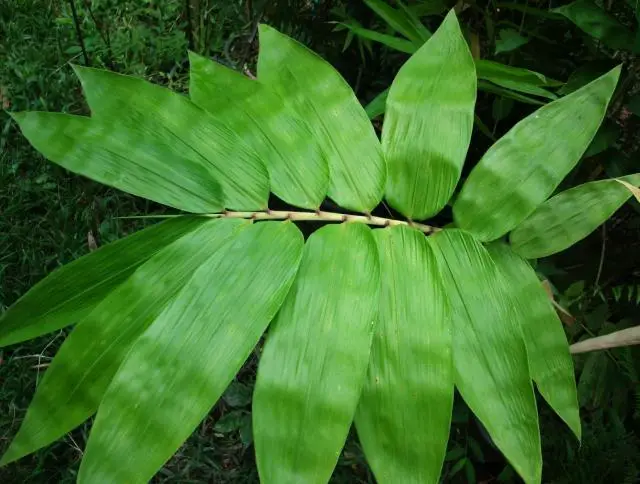

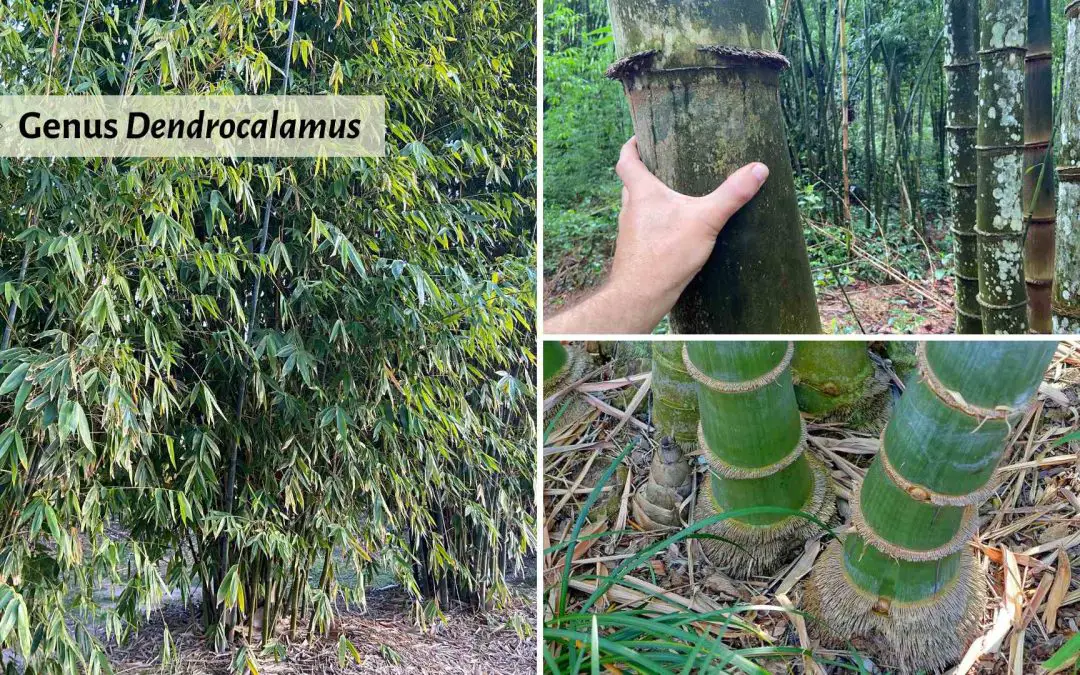
























In n. Cal., where can I buy all of the Dendro ‘s species?
Check out this listing of Bamboo Nurseries in California!
What is the Large Bamboo that I thought was in the Largest Category, I took a few pics of the seeds for sale on ebay but didn’t save the name?
The outside of the bamboo has Almost a true tie dye multiple colored. I remember the do get huge and are some of the widest, and produce a nice Canopy…
Can anybody tell me or have any clue of the Bamboo plant I’m referring to? I have a few pics if need be.
Thank you kindly in advance,
Best Regards,
David
I wish I could help. But if you’re looking for a big ornamental bamboo in a warm, tropical climate, I’d suggest D. giganteus.
where in Laos can I find Dendrocalamus sinicus?
I believe it grows in the north, near the Chinese border.
Hey, I am trying to grow Dendrocalamus giganteus in Greece. What other species of giants should I consider? Zone 9, 600m elevation, 700mm rain
Greece could be challenging for Dendrocalamus. Bambusa will be more successful. I always recommend Oldhamii.
What an fascinating post on Dendrocalamus! I had no idea that these giants could grow so tall and fast. It’s incredible how they play such a vital role in their ecosystems. I’m definitely inspired to learn more about bamboo and its benefits!